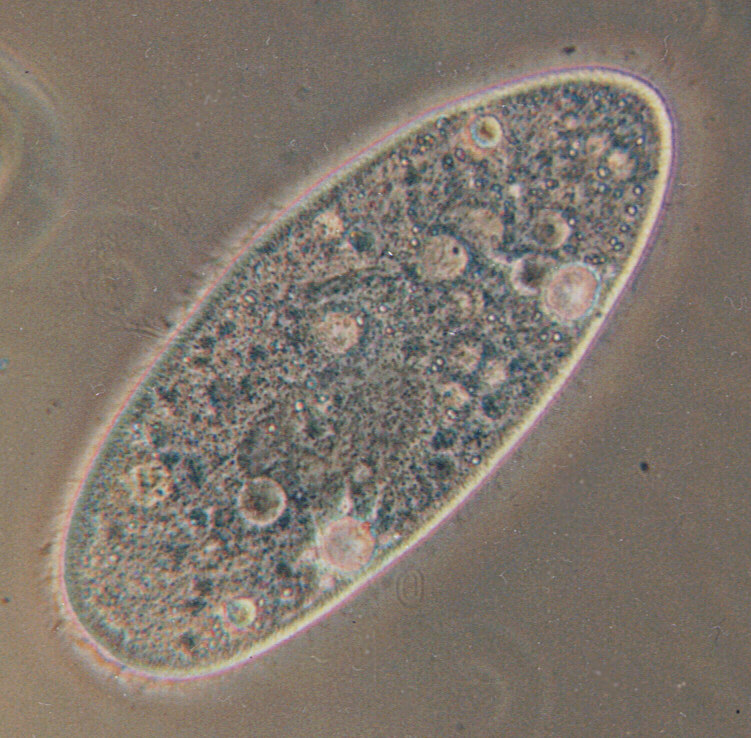- Paramecium
Taxobox
color =
name = Paramecia

image_width = 200px
image_caption = "Paramecium aurelia"
Unicelluar or Multicelluar =Unicellular
domain = Eukaryota
regnum =Protista
super phylum =Alveolata
phylum = Ciliophora
classis =Oligohymenophorea
ordo =Peniculid a
familia =Parameciidae
genus = "Paramecia"
genus_authority = Müller, 1773
subdivision_ranks = Species
subdivision = "Paramecium aurelia "
"Paramecium bursaria "
"Paramecium caudatum "
"Paramecium tetraurelia "Paramecia are a group of
unicellular ciliate protozoa formerly known as “slipperanimalcule s” from theirslipper shape, are commonly studied as a representative of the ciliate group, and range from about 50 to 350 μm in length, depending on species. Simplecilia cover the body, which allow the cell to move with a synchronous motion (like a caterpillar). There is also a deep oral groove containing inconspicuous compound oral cilia (as found in otherpeniculid s) used to draw food inside. They generally feed onbacteria and other small cells.Osmoregulation is carried out by a pair ofcontractile vacuole s, which actively expel water absorbed byosmosis from their surroundings.Paramecia are widespread in freshwater environments, and are especially common in . Paramecia are attracted by
acid ic conditions. Certain single-celled eukaryotes, such as "Paramecium", are examples for exceptions to the universality of the genetic code (translation systems where a few codons differ from the standard ones).Physiology
The paramecium approximates a
prolate spheroid , rounded at the front and pointed at the back. The pellicle is a stiff but elastic membrane that gives the paramecium its definite shape. Covering the pellicle are many tiny hairs, called cilia. On the side beginning near the front end continuing down half way is the oral groove, which collects food until it is swept into the cell mouth. There is an opening near the back end called the anal pore. The contractile vacuole and its radiating canals — referred to previously for osmoregulation of the organism, are also found on the outside of a paramecium.The paramecium contains
cytoplasm ,trichocyst s (“thread capsules”), the gullet, foodvacuoles , themacronucleus , and themicronucleus .Locomotion
For the paramecium to move forward, its cilia beat on an angle, backward. This means that the paramecium moves by spiralling through the water on an invisible axis. For the paramecium to move backward, the cilia simply beat forward on an angle. If the paramecium should run into a solid object, the cilia change direction and beat forward, causing the paramecium to go backward. The paramecium turns slightly and goes forward again. If it runs into the solid object again it will repeat this process until it can get past the object.
Gathering food
Paramecia feed on microorganisms like bacteria, algae, and yeasts. To gather its food, the paramecium uses its cilia to sweep the food along with some water into the cell mouth after it falls into the oral groove. The food goes through the cell mouth into the gullet, which is like the stomach. When enough food has accumulated at the gullet base, it invaginates there to form a food vacuole in the cytoplasm, and travels through the cell, through the back end first. As it moves along, enzymes from the cytoplasm enter the vacuole to digest the contents, digested nutrients then going into the cytoplasm, and the vacuole shrinks. When the vacuole reaches the anal pore, it ruptures, expelling its waste contents to the exterior.
Symbiosis
One of the most interesting known
symbiotic relationships is that of "Paramecium aurelia" and its bacterial endosymbionts. The bacteria infect the protozoa, and they produce toxic particles that kill sensitive strains, but not killer strains. See also the Chlorella symbiosis withParamecium bursaria .Giant
amoeba s, for instance, have 2 types of endosymbiotes, which seem to function asmitochondria in these amoebas. Another example involves protozoa bacteria that produce cellulases to assist the host protozoan with cellulose digestion (similar to those found in some intermites ). This is a cell that appears at quiet ponds.The "paramecium" genome has been sequenced (species: "Paramecium tetraurelia"), providing evidence for three whole-genome duplication. [Aury, J. M., O. Jaillon, et al. (2006). "Global trends of whole-genome duplications revealed by the ciliate "Paramecium tetraurelia"." Nature 444(7116): 171-8. [http://www.ncbi.nlm.nih.gov/sites/entrez?cmd=Retrieve&db=PubMed&list_uids=17086204&dopt=Citation] ]
In some ciliates, like "Stylonychia" and "Paramecium", only UGA decoded as a stop codon, while UAG and UAA are reassigned as sense codons. [Lekomtsev, S, Kolosov, P., et al. (2007) "Different modes of stop codon restriction by the "Stylonychia" and "Paramecium" eRF1 translation termination factors", "PNAS", 104(26):10824-9 [http://www.pnas.org/cgi/external_ref?access_num=17573528&link_type=PUBMED] ]
Learning
The question of whether paramecia exhibit learning has been the object of a great deal of experiment and partaying, yielding equivocal results. In one of the most recent experiments published [ Armus, H.L., Montgomery, A.R., Jellison, J.L. (2006) "Discrimination Learning in Paramecia (P. caudatum)" , The Psychological Record, 56,489-498 [http://www.accessmylibrary.com/coms2/summary_0286-29269289_ITM] ] , the authors, by using a voltage as a reinforcement, concluded that "paramecium" may indeed learn to discriminate between different brightness levels.
References
Wikimedia Foundation. 2010.
